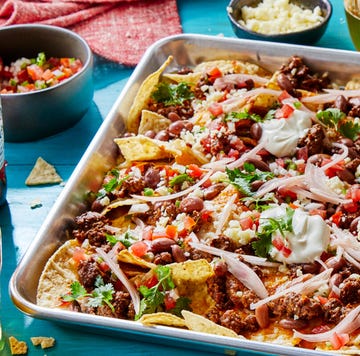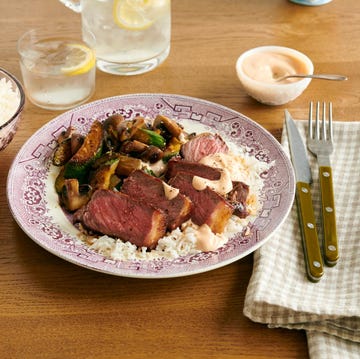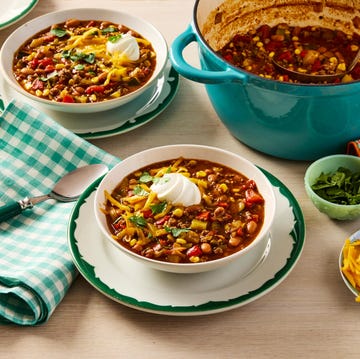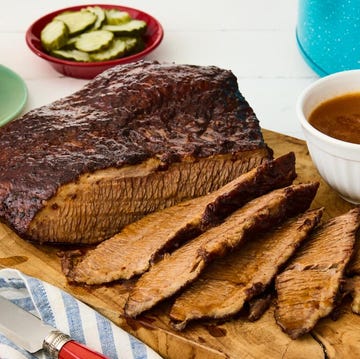In case you didn't know, beef is a staple in the Drummond household. Whether it's chuck roast, brisket, or flank steak, Ree Drummond has been known to cook with all different cuts of beef. But despite living and working on a cattle ranch, Ree often shops for beef at the supermarket, too. "We raise cows and calves and yearlings, so we'll usually sell the cattle before they reach the right size," Ree explains, "Occasionally, however, we'll have one of our animals butchered so we'll have a freezer full of beef."
Of course, not everyone has a cattle ranching family, so knowing which cuts of beef to buy at your supermarket or butcher is important information to know. After all, you don't want to be stuck wondering whether you should get the sirloin or rib-eye when you're making a steak dinner. And which cut of beef is best for Ree's beef stew? Ahead, you'll learn the basics of beef with a handy illustration that makes it easy to navigate.
Plus, there are tips for how to cook each cut of beef, including which ones need time to braise and tenderize compared to cuts that are perfect for a quick sear.
Chuck
Beef chuck is one of the larger sections of the cow that's located near the head. It's known for having a good amount of marbling and connective tissue, but when it's cooked slowly, it can become meltingly tender. That's why you'll often see chuck in braises, stews, pot roast, and slow cooking. Try it in Ree's beef noodle casserole: "There's just nothing better," she says. Cuts from the beef chuck also include flat iron steak and ground chuck, which can be used for your favorite burgers, meatballs, or ground beef casseroles.
Brisket
Just below the chuck is the cut of beef referred to as brisket. It's known for being tough since it acts as the cow's chest to support the weight of the body. But don't let that discourage you from making brisket! With plenty of low and slow cooking, the meat can become tender and packed with flavor. "The fall-apart goodness of this delicious meat is worth every hour," Ree says. You can braise it, smoke it, or pop it in your slow cooker. It's also a popular cut of beef for many barbecue recipes!
Rib
Ah, the rib! It's located high on the back of the cow that doesn't get much exercise, so it's prized for being particularly juicy and tender. You'll often see cuts of the rib used for a Christmas dinner staple: the prime rib (also known as the standing rib roast). "Prime rib sounds impressive and that's because it is impressive," Ree says. It's no wonder it's made on special occasions. But you can use parts of the rib on weeknights, too. For instance, the beef cut from the rib can be used for back ribs, cowboy steaks, or ribeye, which can be roasted, grilled, or pan seared. Just be sure to use your trusty meat thermometer to get the right doneness without drying it out!
Plate
If you look towards the belly of the cow (below the ribs), you'll see the plate—a section that can be tough and high in fat. But don't worry, there's still plenty of flavor when cooked the right way. The plate includes the hanger steak and skirt steak (both of which are great for grilling or searing), along with the short ribs (which can be braised or slow cooked).
Short Loin
Another cut of beef from the top of the cow is the short loin, which is one of the most tender, well-marbled, and expensive cuts of meat. It's part of the back of the animal (or the hindquarter) that includes the T-bone, porterhouse, and strip steaks. There's also a section called the tenderloin that goes from the short loin into the sirloin. When it comes to cooking, you can roast the tenderloin whole and either grill, sear, or broil the steaks. Try a strip steak with garlic butter or cook a T-bone with plenty of Cajun seasoning—the options are endless!
Flank
Just below the loin is the long section of the cow's abdomen called the flank. This type of beef might be more course and chewier than some of the others, but it has plenty of beefy flavor. Flank steak is often used for beef fajitas, marinated steak recipes, or quick cooking methods like grilling. This helps to ensure it doesn't get overcooked!
Sirloin
Located towards the back legs of the cow is the sirloin which is divided into two parts: the top sirloin and the bottom sirloin. To break it down even further, the bottom sirloin consists of cuts like the sirloin steak, tri-tip, bavette, and sirloin tips. The leaner top sirloin is great for grilling while the bottom sirloin can be roasted or cut into cubes and turned into beef stroganoff.
Round
One of the largest sections from the back of the cow is the beef round, which is known for being a budget-friendly cut! Since the back legs of the cow get a lot of exercise, the round cut is mostly lean but sometimes tough. Your best bet when cooking a round roast is to braise it or roast it slowly and slice it thin. Try this roast beef recipe, then turn it into a scrumptious roast beef sandwich!
Shank
Finally, you have the beef shank which comes from both the bottom of the front and back legs. Though it can be very tough and full of connective tissue (since it contains the bone), the beef shank is also a great option for slow braises like the classic dish known as Osso Buco or used when making beef stock.






















